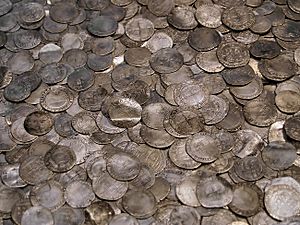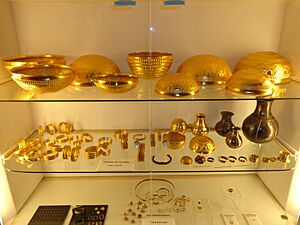Hoard facts for kids

A hoard is like a secret stash of valuable stuff. Imagine someone burying their precious items or cool tools in the ground. They usually plan to dig them up later. Sometimes, though, the person who buried the hoard can't come back for it. Maybe they moved away, forgot where it was, or something else happened. That's when these hidden treasures can be found much later! People with metal detectors, or even archaeologists, might discover them.
Hoards are super helpful for archaeologists. They can tell us about the past. For example, if a lot of hoards are found from a certain time, it might mean people felt unsafe back then. They buried their valuables to keep them safe. In ancient Britain, during the 400s and 500s AD, many hoards were buried. Some famous ones include the Hoxne Hoard, the Mildenhall Treasure, and the Cuerdale Hoard. You can see these amazing finds at the British Museum today.
Contents
Different Kinds of Hoards
Hoards can be made of many things. They might contain valuable metals, coins, tools, or even pottery and glass items. Archaeologists have different names for hoards, depending on what's inside and why they think it was buried.
Founder's Hoard
A founder's hoard often has broken metal objects, metal bars (called ingots), or pieces of metal left over from making things. It might also have finished objects. These hoards were probably buried by metalworkers who planned to melt down the old metal and reuse it later.
Merchant's Hoard
A merchant's hoard is a collection of useful items. Imagine a traveling merchant carrying their goods. They might have buried their items for safety, planning to pick them up later.
Personal Hoard
A personal hoard is a collection of someone's own valuable items. People might have buried these during times of trouble or danger, hoping to keep their treasures safe until things got better.
Loot Hoard
A hoard of loot is a collection of items taken during a raid or battle. This is often what people imagine when they hear "buried treasure"!
Votive Hoard
Votive hoards are different from the others. These items were not meant to be dug up later. Instead, they were purposely left as offerings for ritual purposes. People might have placed them in special places, like watery areas or burial mounds. These hoards can include manufactured goods, animal bones, or even small amulets. The way they were placed (carefully or broken) also tells archaeologists they were offerings. Sometimes, valuable objects given to a temple or church were also considered offerings, but they became the property of that place.


